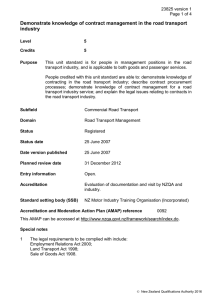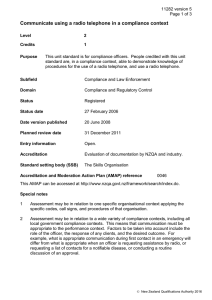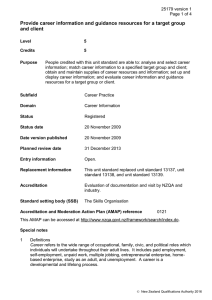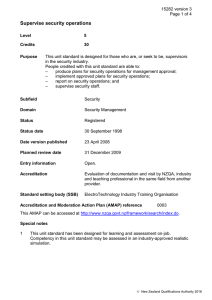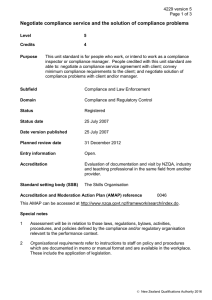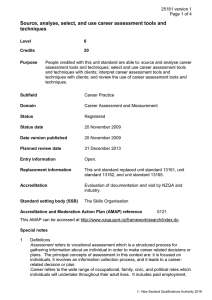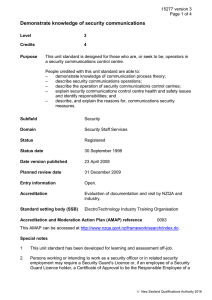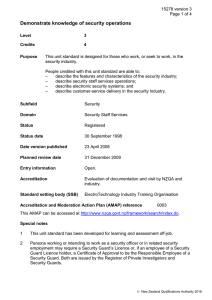Provide technical advice on complex compliance issues and negotiate
advertisement
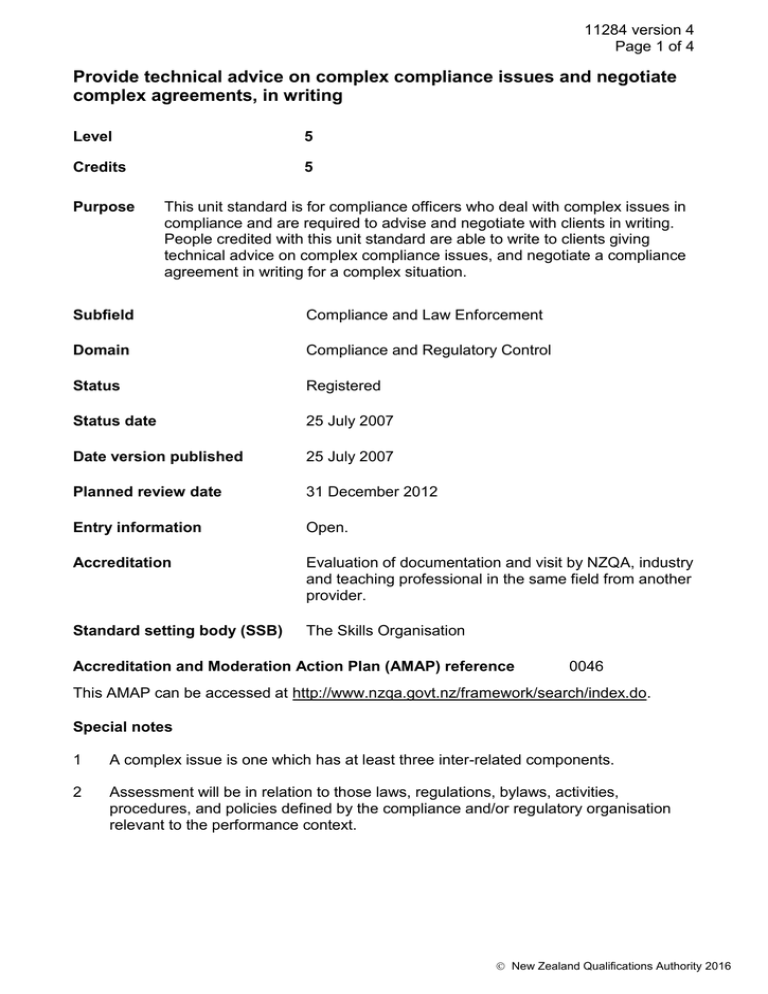
11284 version 4 Page 1 of 4 Provide technical advice on complex compliance issues and negotiate complex agreements, in writing Level 5 Credits 5 Purpose This unit standard is for compliance officers who deal with complex issues in compliance and are required to advise and negotiate with clients in writing. People credited with this unit standard are able to write to clients giving technical advice on complex compliance issues, and negotiate a compliance agreement in writing for a complex situation. Subfield Compliance and Law Enforcement Domain Compliance and Regulatory Control Status Registered Status date 25 July 2007 Date version published 25 July 2007 Planned review date 31 December 2012 Entry information Open. Accreditation Evaluation of documentation and visit by NZQA, industry and teaching professional in the same field from another provider. Standard setting body (SSB) The Skills Organisation Accreditation and Moderation Action Plan (AMAP) reference 0046 This AMAP can be accessed at http://www.nzqa.govt.nz/framework/search/index.do. Special notes 1 A complex issue is one which has at least three inter-related components. 2 Assessment will be in relation to those laws, regulations, bylaws, activities, procedures, and policies defined by the compliance and/or regulatory organisation relevant to the performance context. New Zealand Qualifications Authority 2016 11284 version 4 Page 2 of 4 3 Assessment may be in relation to one specific organisational context applying the specific codes, call signs, and procedures of that organisation, or in relation to a wide variety of compliance contexts, including all local government compliance contexts. This means that communication cannot be narrowly defined but in every case it must be appropriate to the situation being assessed. Factors to be taken into account include the role of the officer, the response of any clients, and the desired outcome. 4 Assessment against element 2 must include the progression of one of the letters used for assessment in element 1; that is, a client is followed from first contact to resolution. Elements and performance criteria Element 1 Write to clients giving technical advice on complex issues in a compliance context. Range at least two letters to external clients, and two submissions to internal clients. Performance criteria 1.1 Opening statement of technical advice specifies the subject of the text. 1.2 Legislation to be complied with is quoted and clearly identified by name, date, section, and clause. 1.3 Situation is described in terms of compliance. Range 1.4 Recommended action is specified. Range 1.5 action advised, reason for preference in terms of local environment constraints, and/or Acts and regulations, and/or safety concerns, and/or other matters. Clear and concise language is used. Range 1.6 includes but is not limited to – client plans submitted, Acts and regulations, local environment constraints, consequences of proposals made (legal, safety), available legal options, ways in which factors inter-relate, possible trade-offs. vocabulary, sentence construction, active verbs, order of information, headings. Organisational policies and procedures for writing are followed. Range may include but is not limited to – format, referencing. New Zealand Qualifications Authority 2016 11284 version 4 Page 3 of 4 Element 2 Negotiate a compliance agreement in writing for a complex situation. Range a series of at least three letters to one client. Performance criteria 2.1 Opening statement specifies the subject of the negotiation and lists the points that require negotiation to agreement. 2.2 Legislation to be complied with is quoted accurately, and is clearly identified by name, date, section, and clause. 2.3 Situation is described in terms of compliance. Range client plans submitted, analysis of client proposals or counterproposals in terms of acceptability, disputed issues, analysis of officer’s preferred options in terms of constraints in the local environment, safety, Acts and regulations, and other considerations; other options for compliance; possible compromises. 2.4 Conclusion specifies final points of agreement and any further proposals required for compliance. 2.5 Clear and concise language is used. Range 2.6 vocabulary, sentence construction, active verbs, order of information, headings. Organisational policies and procedures for writing are followed. Range may include but is not limited to – format, referencing. Please note Providers must be accredited by NZQA, or an inter-institutional body with delegated authority for quality assurance, before they can report credits from assessment against unit standards or deliver courses of study leading to that assessment. Industry Training Organisations must be accredited by NZQA before they can register credits from assessment against unit standards. Accredited providers and Industry Training Organisations assessing against unit standards must engage with the moderation system that applies to those standards. New Zealand Qualifications Authority 2016 11284 version 4 Page 4 of 4 Accreditation requirements and an outline of the moderation system that applies to this standard are outlined in the Accreditation and Moderation Action Plan (AMAP). The AMAP also includes useful information about special requirements for organisations wishing to develop education and training programmes, such as minimum qualifications for tutors and assessors, and special resource requirements. Comments on this unit standard Please contact The Skills Organisation info@skills.org.nz if you wish to suggest changes to the content of this unit standard. New Zealand Qualifications Authority 2016
